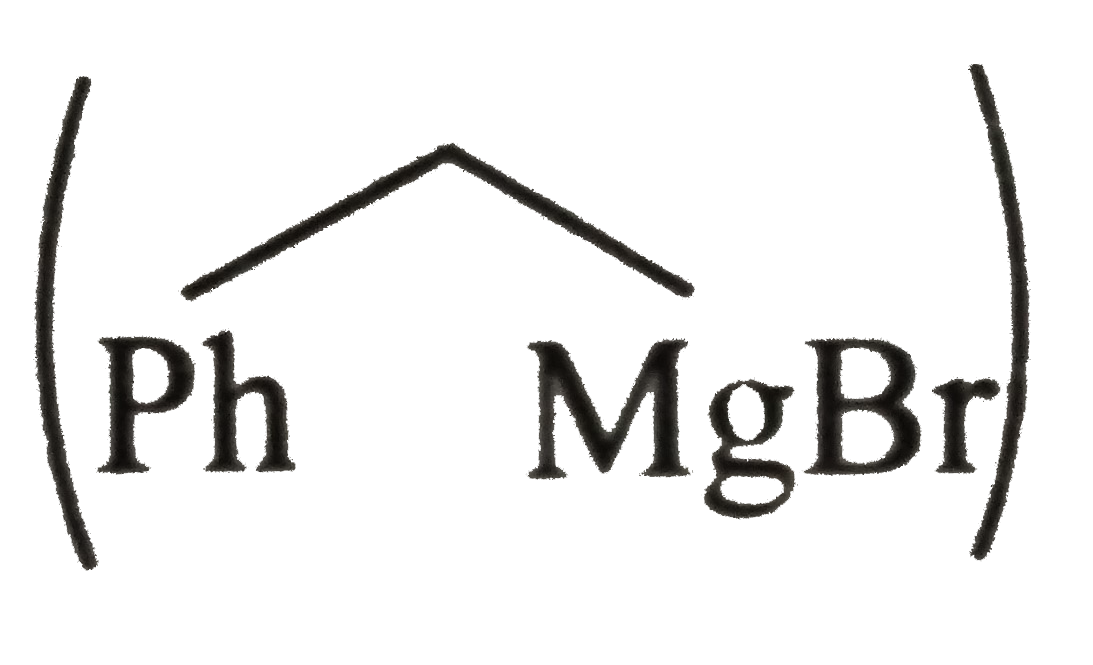Two different G.R.(A) and (B) give the product (X)  on reaction with (C) and (D) respectively. Give the structures of (A),(B),(C) and (D).
on reaction with (C) and (D) respectively. Give the structures of (A),(B),(C) and (D).
Product (X)  (2−Methyl−2−phenyl−∝an−2−ol) is a 3∘ alcohol which can be obtained by the reaction of ketone with G.R.
(2−Methyl−2−phenyl−∝an−2−ol) is a 3∘ alcohol which can be obtained by the reaction of ketone with G.R.
G.R can be either MeMgBr(A) or  (B).
(B).
The ketone can be either 
The reactions are as follows
 .
.
Topper's Solved these Questions
- GRIGNARD REAGENTS AND ORGANOMETALLIC REAGENTSBook:CENGAGE CHEMISTRYChapter:GRIGNARD REAGENTS AND ORGANOMETALLIC REAGENTSExercise:Exercises (Subjective )
Explore 17 Videos
- GRIGNARD REAGENTS AND ORGANOMETALLIC REAGENTSBook:CENGAGE CHEMISTRYChapter:GRIGNARD REAGENTS AND ORGANOMETALLIC REAGENTSExercise:Exercises (Linked Comprehension)
Explore 33 Videos
- GRIGNARD REAGENTS AND ORGANOMETALLIC REAGENTSBook:CENGAGE CHEMISTRYChapter:GRIGNARD REAGENTS AND ORGANOMETALLIC REAGENTSExercise:Exercises Archives (Linked Comprehension)
Explore 1 Video
- GENERAL PRINCIPLES AND PROCESS OF ISOLATION OF ELEMENTSBook:CENGAGE CHEMISTRYChapter:GENERAL PRINCIPLES AND PROCESS OF ISOLATION OF ELEMENTSExercise:Archives (Subjective)
Explore 14 Videos
- NCERT BASED EXERCISEBook:CENGAGE CHEMISTRYChapter:NCERT BASED EXERCISEExercise:Nuclear Chemistry (NCERT Exercise)
Explore 29 Videos
Similar Questions
Two diffeent Grignard reagents (A) and (B) give the product 2-methyl-1-phenylpropan-2-ol (X) on reaction with (C ) and (D ) respectively. Give the structures of (A),(B),(C ) and (D).
View Solution
(A) and (C) are isomers, (B) can be obtainedn by the products of the reactions of EtMgBr and acetone . Give the structures of (A),(B), and (C).
. Give the structures of (A),(B), and (C).
View Solution(A), (B) and (C ) are three non-cylic funtional isomers of a carbonyl compound with molecular formula C4H8O. Isomers (A) and (C ) give positive Tollen's test whereas isomer (B) does not give Tollens' test but gives positive iodoform test. Isomers (A) and (B) on reduction with Zn(Mg) | conc. HCl give the same product (D).
(a) Write the structures of (A), (B) ,(C) and (D).
(b) Out of (A), (B) and (C ) isomers, which one is least reactive towards addition of HCN ?
View Solution(A), (B) and (C) are three non-cyclic functional isomers of a carbonyl compound with molecular formula C4H8O. Isomers (A) and (C) give positive Tollens' test whereas isomer (B) does not give Tollens' test but gives positive Iodoform test. Isomers (A) and (B) on reduction with Zn(Hg)/conc. HCl give the same product (D).
(a) Write the structures of (A), (B), (C) and (D).
(b) Out of (A), (B) and (C) isomers, which one is least reactive towards addition of HCN ?
View Solution
Give the products (B) and (C) in the above reaction.
View SolutionAn organic compound (A) (C6H10O) on reaction with CH3MgBr followed by acid treatment gives compound (B). The compound (B) on ozonolysis gives compound (C ), which in the presence of a base gives 1-acetyl cyclopentane (D). The compound (B) on reaction with HBr gives compound (E ). Write the structures of (A), (B), (C ), (D), and (E ). Show how (D) is formed from (C ).
View SolutionAn organic compound (A) (C6H10) on reaction with CH3MgBr followed by acid treatment gives compound (B). The compound (B) on ozonolysis gives compound (C ), which in the presence of a base gives 1-acetylcyclo-pentene (D). The compound (B) on reaction with HBr gives (E ). Write the structures of (A), (B), (C ), and (E). Show how (D) is formed form (C ).
View SolutionA Grignard reagent (A) and a haloalkene (B) react together to give (C) . Compound (C) on heating with KOH yeilds a mixture of two geometrical isomers (D) and € of which (D) predominates . Compound (C) on reaction with HBr in presence of a peroxide gives 1-bromo-3- phenylpropane. Give the structures of (A), (B) and (C) and configurations of (D) and (E).
View SolutionLabel A,B,C and D is the given figure. Give the function of B

View SolutionWhen bromobenzene is monochlorinated two isomeric compounds (A) and (B) are obtained. Monobromination of (A) gives several isomeric products of molecular formula C6H3CIBr2 while monobromination of (B) yields only two isomers (C) and (D). compound (C) is identical with one of the compounds obtained from the bromination of (A), however (D) is totally different from any of the isomeric compounds obtained from the bromination of (A). Give the structure of (A),(B),(C) and (D) and also structures of isomeric monobrominated products of(A). Support your answer with reasoning.
View Solution

